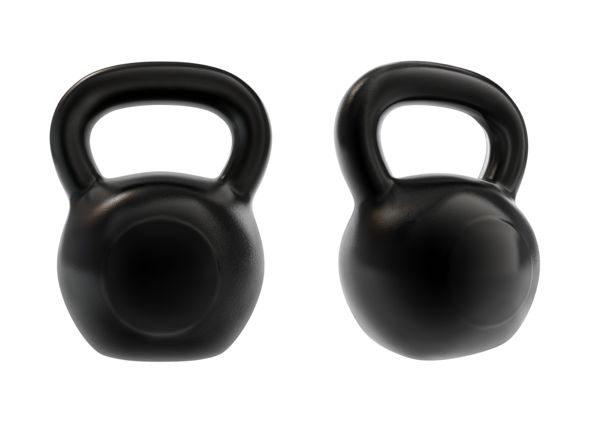
By Betsy Collie
Athletes across the globe are discovering the benefits of kettlebell training. Kettlebell training was initially used by elite Russian athletes – skyrocketing their performance at international competitions. Runners can now benefit from the dynamic training approach unique to kettlebell training. This total body, strength and cardio, core conditioning training approach is being used by mixed martial artists, professional football teams, track and field athletes, Navy SEALS, law enforcement personnel, firefighters and now runners.
Why the Kettlebell and How is It Different?
Due to the bell sitting below the handle instead of between it, the kettlebell’s weight is off-set in the hand, causing the body to use more muscles to hold and move the bell. This causes the body to use more energy, which is convenient if one of your goals is to lose weight. No other form of conditioning can provide the dynamic effect of kettlebell training.
Strength Training
Most strength training approaches are relatively static, but not kettlebell training. Running athletes, Navy SEALs and firefighters are engaged in dynamic activities making kettlebell training a perfect match. Research has demonstrated that strength training can improve your running times, but what is the best approach? With kettlebell training a runner can focus on the areas that will most benefit runners: feet, calves, quadriceps, hamstrings, gluteals and abs. Not only do these exercises hit the key areas – the dynamic nature of kettlebell training makes them extremely functional and specific to running. Running is a dynamic sport and requires dynamic training for optimal results. The ballistic shock of KBs teaches you how to absorb shock efficiently which is critical for sports. It is equally important for all of us. Impact happens when we least expect it. Be prepared for life’s little surprises.
Core Training
Many athletes think that doing some crunches is all they need for core training. Wrong! Core muscles are defined as the muscles that run from your shoulders just past the hip flexors on the front of your body, from the shoulders to just past the glutes on the back of your body, not to mention the sides of your body (think obliques, lats,etc.). Some of these muscles attach to your pelvis, with some of these extending to your leg and some to your trunk. There are actually 29 pairs of these muscles. We can’t design exercises to strengthen each of these muscles individually but we can ensure that each of the major muscle groups (abs, hip abductors, gluteals, hip flexors, hamstrings, groin and lower back) are trained. Kettlebell Training does just that.
Balance Training
Balance training is the functional expression of an optimized nervous system, muscular system and skeletal system. Kettlebell Training for the running athlete will work your balance in a dynamic way that you have never experienced before. You will be amazed at the difference balance training can make in your running form and efficiency. Kettlebell Training is done without shoes for the specific purpose of training your foot muscles to become responsive to changing stimulus. Your feet carry most of the proprioception found in the body. This proprioception allows the foot to respond appropriately to the surface that it encounters therefore making all the other parts of the body fire correctly. You will be impressed with how dynamic kettlebell training restores your foot’s natural ability to adapt and propel. The bottom line is that you run better, faster, stronger and more balanced.
Build Strength & Endurance
Often times it is not how strong you are when you are fresh but how strong you remain once you become winded and have expended a lot of energy that determines the outcome. In running, “enduring strength” is a very important skill. The legs may be strong in the beginning of the run but if the core is not strong the running becomes extremely tiring and strength endurance is zero to none with the strength and stamina of the core. This requires tremendous strength/endurance. Kettlebell high repetition snatches, for example, develops a strong work capacity and anaerobic threshold.
Develop Strength at the Extremes of Your Range of Motion
Exercising this way creates the ability to better stabilize your joints, improves flexibility and enhances mobility. Because kettlebell lifts require full-body integration, it is a much better tool than doing high repetition isolation movements with a barbell or dumbbell. The design of the kettlebell differs from that of a dumbbell. With dumbbells the weight is evenly distributed over your hand. When using a kettlebell, there is constant pulling on your core (the muscles from shoulder blades down to your buttocks) for several reasons:
1. Many exercises involve swinging the kettlebell which requires tremendous core strength to keep your body stationary.
2. When you grasp the kettlebell by the handle, the center of mass or ball of the kettlebell is offset or slightly to the side. Pressing the kettlebell or holding it overhead causes a strong activation of your core to keep your body stable and tight.
Most of us who work out in the gym are used to isolating muscles. This is a bodybuilding technique, but it is not an effective way for a runner, or any athlete, to train. With kettlebells you use your buttocks, legs, abs, back, and arms-all at the same time. Kettlebells are extremely time efficient!
Kettlebells will strengthen the “weak” areas of your body and is nothing short of phenomenal at addressing these issues. When performed correctly it can bring huge injury rehabilitation and works wonders for lower-back, hip, knee, and shoulder problems. Kettlebells will also increase your sprinting speed as well aerobic conditioning. The bottom line is that you run better, faster, stronger and more balanced.
# # #
Betsy Collie is the owner, and head kettlebell instructor at Rapid Results Fitness in Durham, NC, specializing in group kettlebell training, yoga, joint mobility, ropes, and personal training. She is an RKC II instructor, Battling Ropes Coach, Z Health Level I Trainer, AFAA certified (PT, Group Fitness, Pilates). She instructs at the National RKC (Russian Kettlebell Challenge) certification courses. Appointed by Pavel Tsatsouline, she has trained the Navy SEALs in Kettlebell training. Contact: 919-403-8651, rapidresultsfitness@gmail.com , www.rapidresultsfitness.net.






